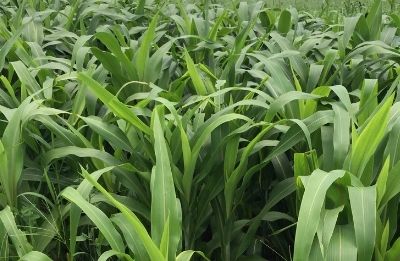 Sorghum (GROWMARK, Inc.)
Sorghum (GROWMARK, Inc.)
- Summer annuals offer alternative forage production tonnage when most perennial forages are not as productive.
- Very drought tolerant, warm weather plants are economical summer-time feedstocks.
- Summer annuals typically grown are forage sorghum, sorghum-sudangrass hybrids, sudangrass, and millet.
During the summer, productivity of our common perennial forages decrease due to increased heat and water stress. In a droughty season, productivity may be extremely reduced, and other alternatives may be sought. This is where summer annual forages come into play: they grow rapidly after a May/June or mid-season planting and have excellent drought tolerance. They can be used for grazing, silage, or even hay. There are several summer annual forages you can choose from. This article provides some quick points on the options you will most frequently encounter.
For silage operations, forage sorghum provides a very good option to corn silage. It can produce nearly the same tonnage as average corn silage when harvested at soft dough stage. Seed at 8-12 lbs. per acre in wide rows, or 20-25 lbs. per acre drilled /broadcast.
Sorghum-sudangrass hybrids are often the best choice for either grazing or hay. This forage has smaller stalks and a quicker regrowth potential than forage sorghums, but tillers weakly. Allow the forage to reach 24“ before grazing. Seed at 25-30 lbs. per acre.
Sudangrass has a small stalk diameter, tillers well, and produces a high leaf to stalk ratio. This forage has excellent regrowth after cutting compared to the other sorghums. It is a multi-cut forage which can allow for fewer acres planted or a rotational grazing program. Seed at 20-25 lbs. per acre.
Note: The brown midrib 6 trait of certain sorghums confers 40-60% less lignin than other sorghums, allowing for higher digestibility. The BMR 6 trait is available in forage sorghum, sorghum-sudangrass, and sudangrass.
Millets are similar to sorghums, in growth and utility, but without dangers of prussic acid. Slightly less productive and slower growing than sudangrass. Often used in a rotational grazing scenario, but millet can also produce a hay crop. Seeded at 20-25 lbs. per acre. It can make a good hay if it is cut when plants are 24"-36” tall.
Whether summer annuals are used for grazing or hay, leave 4-6 inches of stubble at harvest to allow for more rapid regrowth. Contact your FS Crop Specialist for more information.